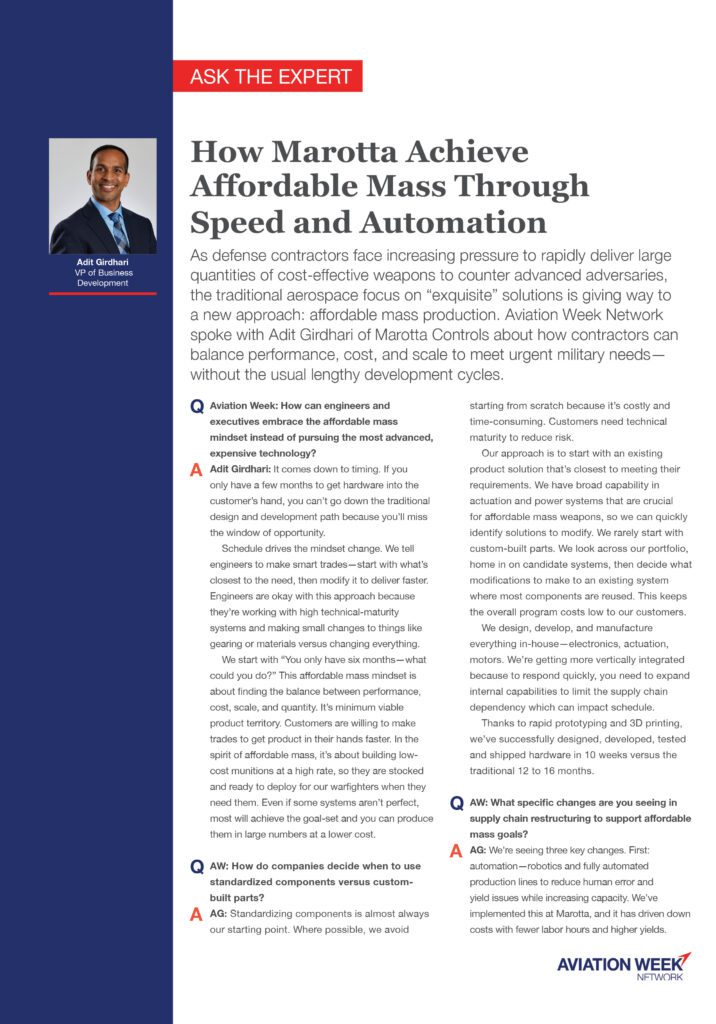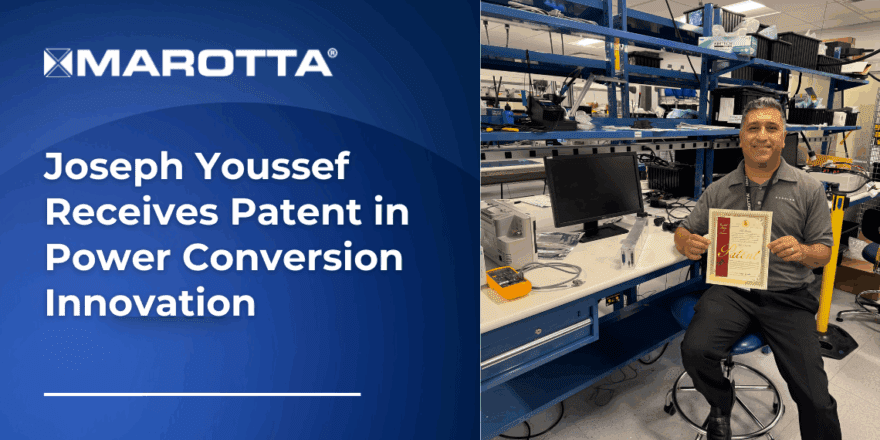How Marotta Achieves Affordable Mass Through Speed and Automation
As defense contractors face increasing pressure to rapidly deliver large quantities of cost-effective weapons to counter advanced adversaries, the traditional aerospace focus on “exquisite” solutions is giving way to a new approach: affordable mass production. Aviation Week Network spoke with Adit Girdhari of Marotta Controls about how contractors can balance performance, cost, and scale to meet urgent military needs—without the usual lengthy development cycles.
Link to original publication on AviationWeek
Q:
Aviation Week: How can engineers and executives embrace the affordable mass mindset instead of pursuing the most advanced, expensive technology?
A (Adit Girdhari):
It comes down to timing. If you only have a few months to get hardware into the customer’s hand, you can’t go down the traditional design and development path because you’ll miss the window of opportunity.
Schedule drives the mindset change. We tell engineers to make smart trades—start with what’s closest to the need, then modify it to deliver faster. Engineers are okay with this approach because they’re working with high technical-maturity systems and making small changes to things like gearing or materials, versus changing everything.
We start with “You only have six months—what could you do?” This affordable mass mindset is about finding the balance between performance, cost, scale, and quantity. It’s a minimum viable product territory. Customers are willing to make spirit of affordable mass, it’s about building low-cost munitions at a high rate, so they are stocked and ready to deploy for our warfighters when they need them. Even if some systems aren’t perfect, most will achieve the goal set and you can produce them in large numbers at a lower cost.
Q:
AW: How do companies decide when to use standardized components versus custom-built parts?
A:
ADIT: Standardizing components is almost always our starting point. Where possible, we avoid starting from scratch because it’s costly and time-consuming. Customers need technical maturity to reduce risk.
Our approach is to start with an existing product solution that’s closest to meeting their requirements. We have broad capability in actuation and power systems that are crucial for affordable mass weapons, so we can quickly identify solutions to modify. We rarely start with custom-built parts. We look across our portfolio, home in on candidate systems, then decide what modifications to make to an existing system where most components are reused. This keeps the overall program costs low to our customers.
We design, develop, and manufacture everything in-house—electronics, actuation, motors. We’re getting more vertically integrated because to respond quickly, you need to expand internal capabilities to limit the supply chain dependency which can impact schedule. Thanks to rapid prototyping and 3D printing, we’ve successfully designed, developed, tested and shipped hardware in 10 weeks versus the traditional 12 to 16 months.
Q:
AW: What specific changes are you seeing in supply chain restructuring to support affordable mass goals?
A:
ADIT: We’re seeing three key changes. First: automation—robotics and fully automated production lines to reduce human error and yield issues while increasing capacity. We’ve implemented this at Marotta, and it has driven down costs with fewer labor hours and higher yields.
Second: vertical integration. Suppliers are adding more value to their offerings by doing more testing at their level so we can eliminate that need on our side when parts arrive. We’ve brought long lead and hard-to-source components in-house, eliminating the weeks-long RFQ cycle.
Third: more aggressive non-traditional suppliers that are hungrier and eager to get involved. They’re willing to start work in advance of orders to avoid wasting valuable program schedule. Some suppliers are also leaning-in and stocking parts with high demand to enable reduced lead-times.
Q:
AW: How is this approach changing weapon design requirements, especially for smaller precision weapons that work with stealth aircraft?
A:
ADIT: The key question becomes: what tradeoffs are you willing to accept? You can’t support customization when timeline dictates everything. If you must produce hardware in months and not years, that determines what requirements you can achieve.
For smaller precision weapons in stealth aircraft, the platform volume constraints are clearly understood. The focus shifts to loadout and timing. They set objective and threshold requirements, but now the threshold becomes “threshold with trades.” You’re taking performance hits to threshold requirements because pursuing even the threshold level can be too costly and slow.
The real challenge is identifying must-haves versus nice-to-haves and understanding your true requirements. This means optimizing production processes over design because scale matters most. Companies should focus on ramping production rates through manufacturing optimization—not upfront design.
Q:
AW: What should defense companies track to know if they’re successfully implementing affordable mass? Where should they invest first?
A:
ADIT:
Success depends on meeting the mission set. First metric: did you hit the customer’s minimum performance threshold? If not, you’re back to the drawing boards. Start by meeting the minimum customer requirements; if it can’t do the job, quantity doesn’t matter. The second metric is cost per unit off the line— that’s your affordable mass indicator. Once you understand costs, you can ramp while managing to stay within control limits. Where to invest first? Automation and production line setup. This differs from traditional approaches where you establish a line first, then add improvements. With affordable mass, you build with automation from the get-go. You’re investing upfront because you don’t have time for step-by step implementation. The approach is: customer acceptance of product performance, you hit the cost targets, and in parallel, the production team builds an automated line so you can deliver high volumes in months instead of years.




